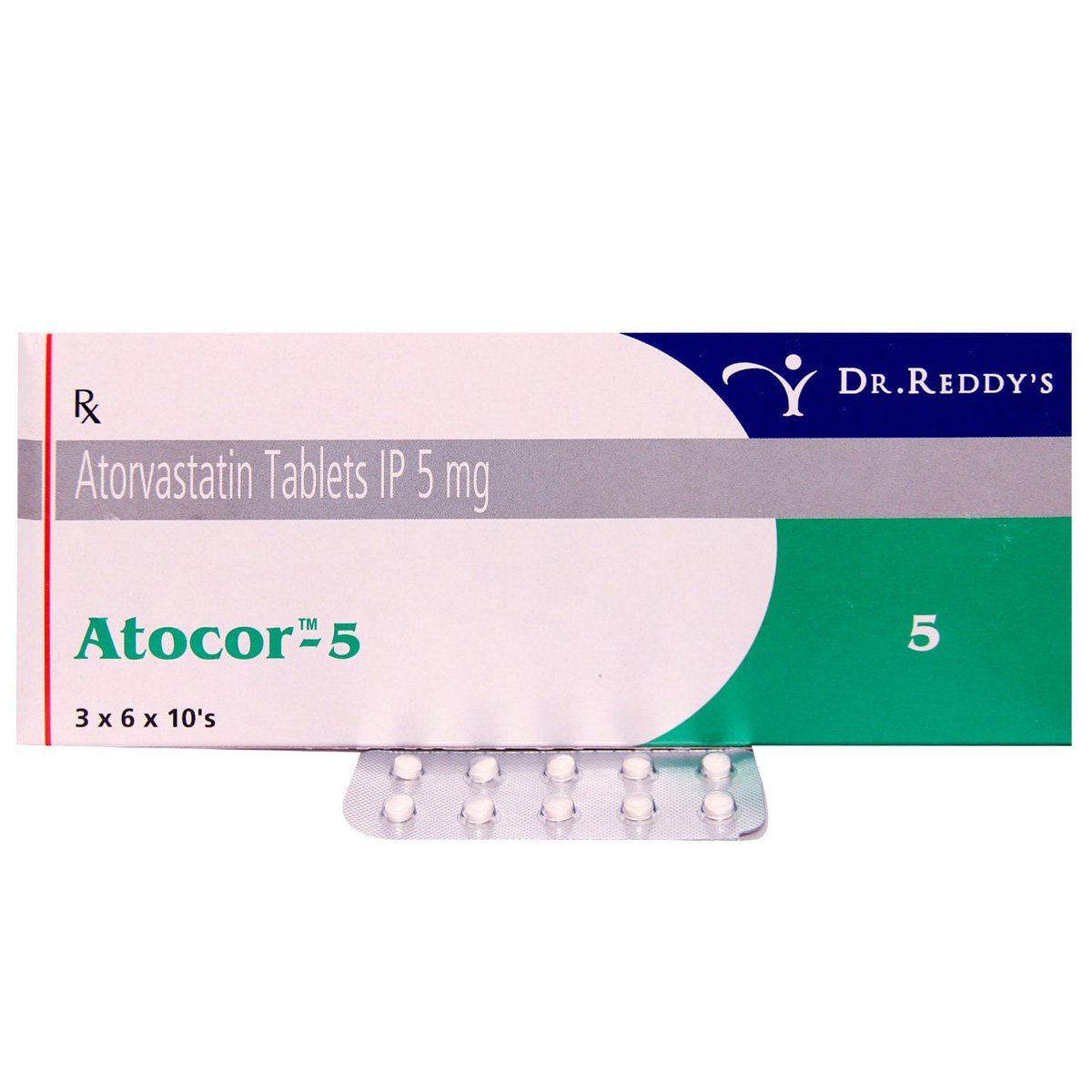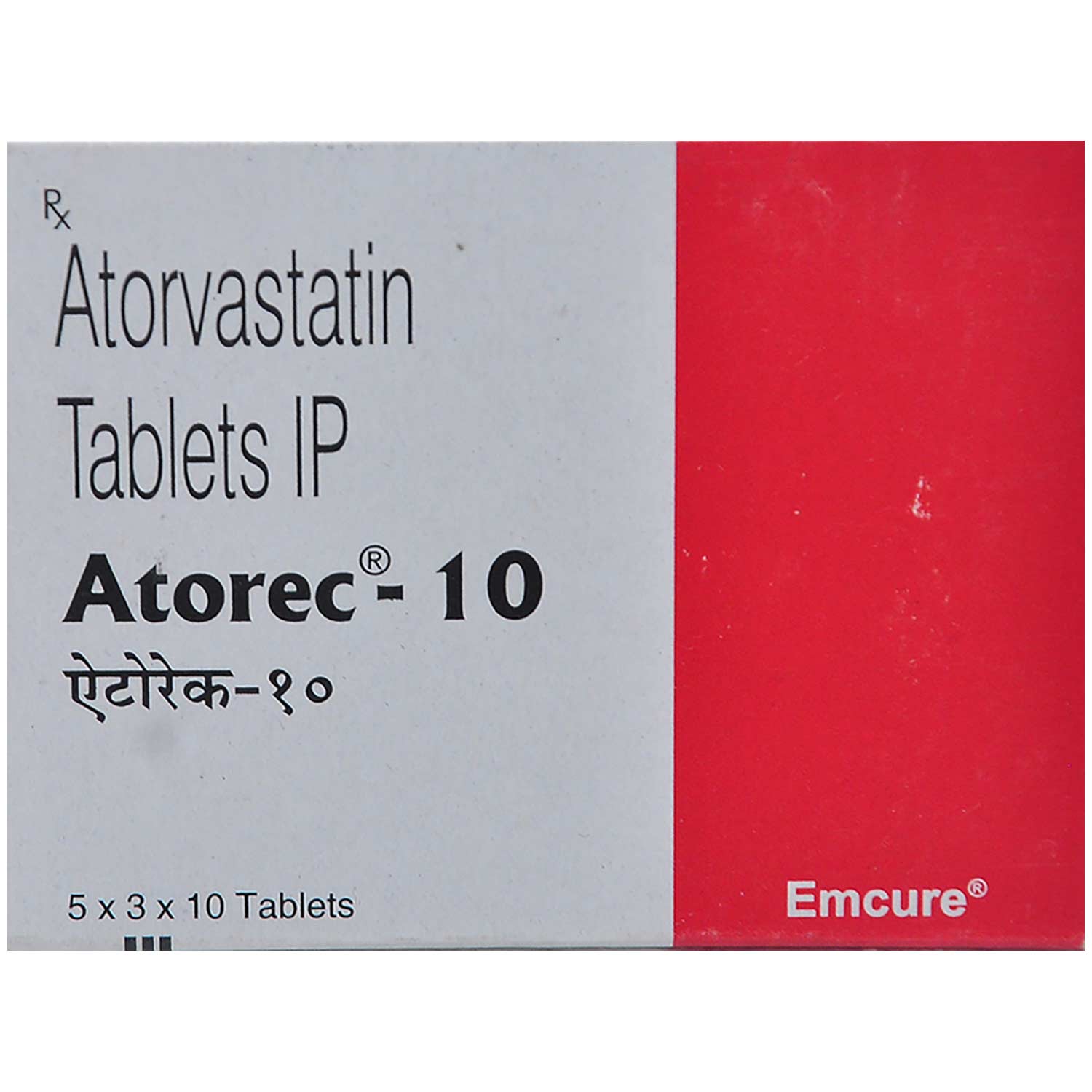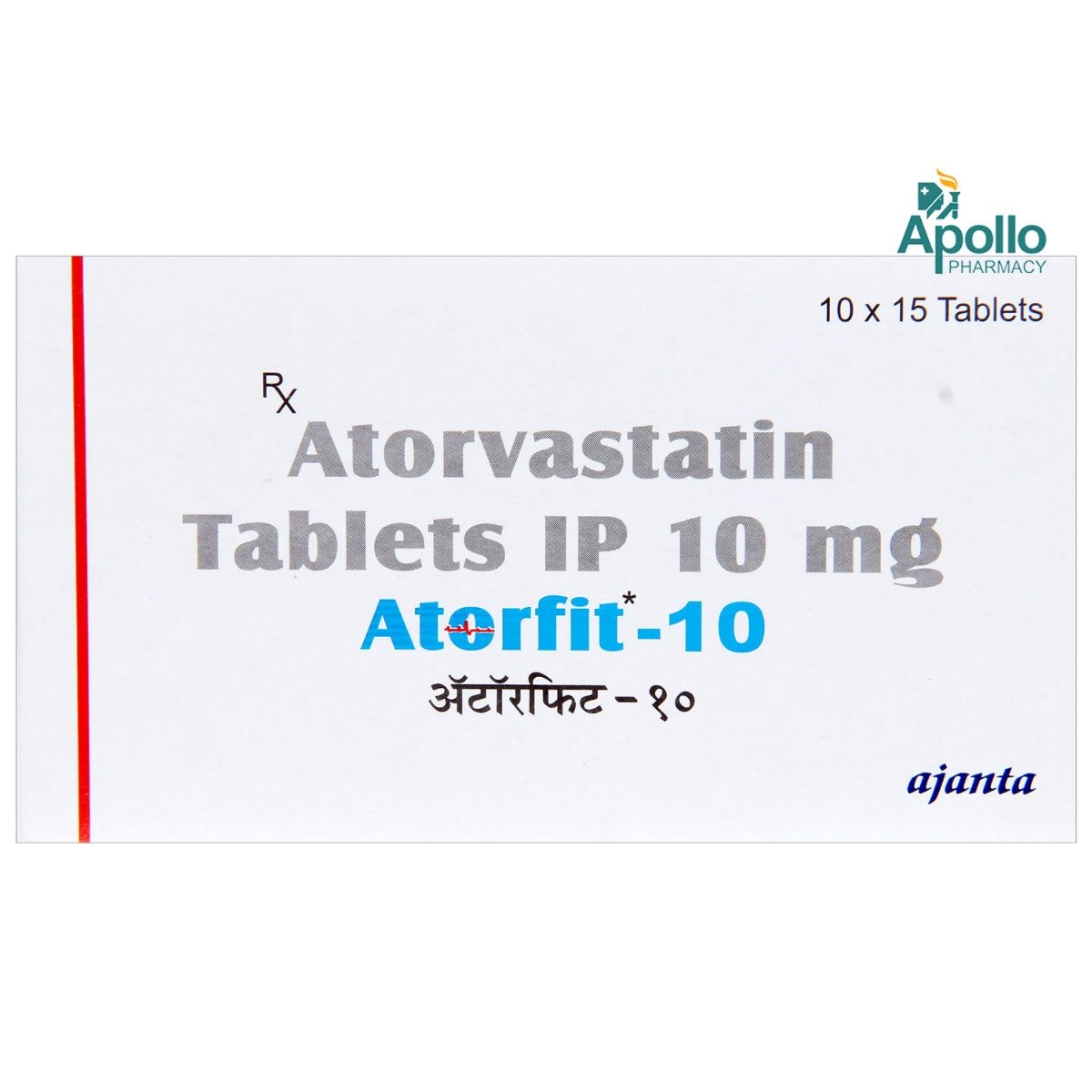Atorvastatin
About Atorvastatin
Atorvastatin belongs to a class of medications called statins to treat raised cholesterol levels in our body. Atorvastatin helps lower the level of low-density lipoprotein (LDL) or bad cholesterol in the blood and increase the level of high-density lipoprotein (HDL) or good cholesterol. Dyslipidaemia is the deposition of unhealthy fat (lipid) levels in the blood. In this condition, there is always a high level of low-density lipoprotein (LDL or bad cholesterol), triglycerides (TG) and a low level of high-density lipoprotein (HDL or good cholesterol).
Atorvastatin contains 'Atorvastatin' which works by slowing the production of cholesterol in the body to decrease the amount of cholesterol that may build up on the arteries walls and block blood flow to the heart, brain, and other parts of the body. Atorvastatin helps to decrease the production of cholesterol that may build up in the blood vessels (arteries) of the heart, brain, and other parts of the body. Lowering cholesterol levels helps prevent heart diseases such as heart attacks and strokes in the future. Atorvastatin can also be prescribed for people with a family history of raised cholesterol in coronary heart disease or long-term health conditions of type 1, type 2 diabetes, or rheumatoid arthritis.
The prescribed dose of Atorvastatin is daily once a day at the same time. Your doctor will advise you on how often you take your tablets based on your medical condition. You can take Atorvastatin with food or without food. It should be swallowed whole with a glass of water. Do not chew, bite, or break it. In a few cases, you may experience allergic reactions, hyperglycaemia (excess of glucose in the bloodstream), headache, vision blurred, pain, constipation, nausea, diarrhoea, muscle spasms, joint swelling, and back pain. Most of these side effects of Atorvastatin do not require medical attention and gradually resolve over time. Consult your doctor immediately if you have yellowing eye/skin (jaundice), dark urine, or repeated unexplained muscular pain.
Atorvastatin may cause a breakdown of skeletal muscle tissue, leading to kidney failure. This condition usually occurs in the elderly, people with kidney disease, and poorly controlled hypothyroidism (underactive thyroid). Atorvastatin should not be prescribed to children less than ten years of age. You should contact a doctor before if you have had an allergic reaction to Atorvastatin, have liver or kidney problems, pregnant or planning to get pregnant, are breastfeeding, have severe lung disease, have a previous heart attack or stroke caused by bleeding in the brain, have hypothyroidism, drink more than two servings of alcohol per day and have a muscle disorder (fibromyalgia). The efficiency of Atorvastatin can be increased by taking low-fat or cholesterol-containing food and drinks.
Uses of Atorvastatin
Medicinal Benefits
Atorvastatin taken with dietary measures helps treat high cholesterol, especially for heart patients when initial dietary measures fail to lower cholesterol. It helps lower the bad cholesterol (LDL) and increases the level of good cholesterol (HDL) in the state of dyslipidaemia or hyperlipidaemia. Atorvastatin is considered more effective compared to other statins. Atorvastatin also lowers the amount of fat or cholesterol deposition (plaque) in the heart's arteries, thereby reducing the chance of having a heart attack or stroke in the future.
Directions for Use
Storage
Side Effects of Atorvastatin
- Headache
- Blurred Vision
- Muscle Weakness
- Allergic Reactions
- Hyperglycaemia (Excess glucose in the bloodstream)
- Constipation
- Nausea
- Diarrhoea
- Joint Swelling
- Back Pain
Drug Warnings
Atorvastatin may cause a breakdown of skeletal muscle tissue, leading to kidney failure. This condition usually occurs in the elderly, people with kidney disease, and poorly controlled hypothyroidism (underactive thyroid). Atorvastatin should not be prescribed to children less than ten years of age. You should contact a doctor before if you have had an allergic reaction to Atorvastatin, have a liver problem (jaundice, liver cirrhosis), or kidney problems, are pregnant or planning to get pregnant, are breastfeeding, have severe lung disease, have a previous heart attack or stroke caused by bleeding in the brain, have hypothyroidism, drink more than two servings of alcohol per day and have a muscle disorder (fibromyalgia) and damaged muscle tissue (rhabdomyolysis).
Drug Interactions
Drug-Drug Interactions: This medicine may have interaction with antibiotics (like cephalexin, tetracycline, gentamicin), antifungals (like miconazole, fluconazole, and ketoconazole), HIV medicines (like abacavir, retrovir, and tenofovir), hepatitis C medicines (like ribavirin, elbasvir), anti-arthritis pills (cyclosporin), heart rate-controlling pills (amiodarone) and anti-hypertensive drugs (like verapamil, diltiazem).
Food-Drug Interactions: Atorvastatin may interact with grapefruit. It increases the concentration of Atorvastatin in your body.
Drug-Disease Interactions: Patients with serious liver disease (jaundice), kidney disease, lung disease, and muscle weakness (rhabdomyolysis) should be closely monitored while having treatment with Atorvastatin.
Drug-Drug Interactions Checker List:
Safety Advice

Alcohol
unsafeDo not drink too much while taking this medicine. drinking a lot of alcohol you may more likely to get muscle and liver side effects.

Pregnancy
cautionAtorvastatin is not recommended during pregnancy. Contact your doctor before taking Atorvastatin.

Breast Feeding
cautionBreastfeeding is not recommended. Contact your doctor before taking Atorvastatin.

Driving
unsafeAtorvastatin has negligible influence on the ability to drive and use machines.

Liver
cautionAtorvastatin to be taken with caution, especially if you have a history of Liver diseases/conditions. The dose may have to be adjusted by your doctor.

Kidney
cautionAtorvastatin to be taken with caution, especially if you have a history of Kidney diseases/conditions. The dose may have to be adjusted by your doctor.

Children
unsafeAtorvastatin is not indicated in the treatment of patients below the age of 10 years.
Habit Forming
Diet & Lifestyle Advise
- Try aromatherapy, yoga, meditation to help relax your body and mind.
- Try to do breathing exercises to get more oxygen.
- Eat a healthy diet especially rich in soluble fibre like beans, legumes, whole grain, flax, apples, and citrus fruits.
- Try to replace most of your saturated fats with unsaturated fats that can reduce total cholesterol and LDL cholesterol quickly like avocados, olive oil, fatty fish, and nuts contain lots of heart-healthy unsaturated fats, so it’s beneficial to eat them regularly.
- Try to adopt a Mediterranean-style diet rich in olive oil, fruits, vegetables, nuts, whole grains, and fish, and low in red meat and most dairy.
- Try to give priority to more fruits and veggies in your daily meal as these contain antioxidants which help to lower LDL
- Minimize the intake of added sugar. The American Heart Association (ADA) recommends, one should not eat more than 100 calories (25 grams) of added sugar for women and children, and no more than 150 calories (37.5 grams) for men every day.
- American Heart Association recommends that sodium chloride (table salt) should intake not exceed more than 2,300 mg per day as part of a healthy eating pattern.
- As a precautionary measure, do not consume alcohol and quit smoking.
Special Advise
- Suppose muscle fatigue or muscle pain affects your daily activity. Try to contact the doctor if you have muscle weakness or fatigue.
Patients Concern
Disease/Condition Glossary
High cholesterol: Cholesterol is a waxy substance produced by the liver to protect nerves, make tissue, and various hormones. Our body also receives cholesterol from food, like cooking oils, eggs, meats, and dairy products. Excess cholesterol is bad for our health. There are two types of cholesterol: ' bad cholesterol' and 'good cholesterol'. Bad cholesterol comprises low-density lipoprotein (LDL) and triglycerides (TG), while good cholesterol consists of high-density lipoprotein (HDL). Usually, there are no specific symptoms of raised or high cholesterol levels but a large deposition of cholesterol in the arteries (plaque) or heart blockage. Blocked artery or plaque formation in the heart's arteries can lead to chest pain (angina), heart attack, or stroke. So it is advisable to have complete cholesterol tests (lipid profile tests) at least once a year. It will help you closely monitor your heart health and risk of heart attack and stroke.
FAQs
Yes. Muscle weakness can be the long-term side effect of Atorvastatin. You may have muscle fatigue or muscle pain which affects your daily activity. Try to contact the doctor if you have muscle weakness or fatigue.
No, there's no evidence that atorvastatin is addictive.
Atorvastatin can raise your blood sugar a little. If you already have type 2 diabetes, please consult your doctor. Your doctor may adjust the dosage of Atorvastatin.
There's no strong evidence to suggest that taking Atorvastatin will reduce fertility in either men or women. However, it is advisable to consult a doctor before taking it if you're likely to get pregnant or pregnant.
Increase your daily diet with fibre, fruits, vegetables, whole grains and fish, and cut saturated fat as well. Stop smoking and drinking and try to work out every day as well.
No, you should not stop taking Atorvastatin without consulting your doctor. Please take advice from the doctor before quitting.
Yoghurt is a probiotic that can help lower the raised cholesterol level if taken with Atorvastatin. Yoghurt eaters have a better metabolic profile than those who don't eat yoghurt.
There is no firm clinical evidence that states that intake of Atorvastatin causes harm to the baby. However, Atorvastatin passes into the breast milk and may harm the baby. So, you should consult a doctor if you are a nursing mother and taking Atorvastatin.
People affected with hypothyroidism (underactive thyroid), muscle weakness, joint pain, kidney disease, diabetes, liver disease, uncontrolled epilepsy, high or low potassium level, or severely low blood pressure.

.jpg?tr=q-85)







